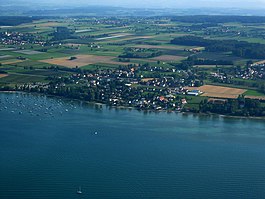Scherzingen
| Münsterlingen | ||
|---|---|---|
 |
||
|
||
| Coordinates: 47°38′N 9°14′E / 47.633°N 9.233°ECoordinates: 47°38′N 9°14′E / 47.633°N 9.233°E | ||
| Country | Switzerland | |
| Canton | Thurgau | |
| District | Kreuzlingen | |
| Area | ||
| • Total | 5.42 km2 (2.09 sq mi) | |
| Elevation | 405 m (1,329 ft) | |
| Population (Dec 2015) | ||
| • Total | 3,199 | |
| • Density | 590/km2 (1,500/sq mi) | |
| Postal code | 8596, 8597 | |
| SFOS number | 4691 | |
| Surrounded by | Altnau, Bottighofen, Constance (Konstanz) (DE-BW), Güttingen, Hagnau am Bodensee (DE-BW), Langrickenbach, Lengwil, Meersburg (DE-BW), Stetten (DE-BW) | |
| Website |
www SFSO statistics |
|
Münsterlingen is a municipality in the district of Kreuzlingen in the canton of Thurgau in Switzerland.
In 1994 the municipality was created from Landschlacht and Scherzingen. Münsterlingen is first mentioned in 1125 as Munsterlin. Scherzingen is first mentioned in 1150 as Scherzingen and Landschlacht is first mentioned in 817 as Lanchasalachi.
Neolithic and Bronze Age stilt houses were discovered in Scherzingen along with numerous neolithic artifacts in Landschlacht.
During the Middle Ages Scherzingen was owned by the Bishop of Constance and, until 1798, was part of the bailiwick of Eggen. In 1280, the monastery of Münsterlingen acquired the right to tithes in Scherzingen, from Constance. The parish of Münsterlingen, which included Scherzingen, Bottighofen, Rickenbach (until 1709) and Oberhofen (after 1712), had a long association with the monastery but converted quickly to the Reformation.
Landschlacht was also owned by the Bishop of Constance, but during the High Middle Ages, the bailiff was the Baron of Güttingen. In 1413 a half share of the low court was sold to Hans Duerrmüller and ten secondary investors from Landschlacht. The other half went to Petershausen monastery in 1452 and in 1486 to Münsterlingen Abbey. In 1621 the eleven investors families sold their share of the court to Münsterlingen, where it remained until 1798. Landschlacht was always part of the parish of Altnau. The chapel of St. Leonhard was built before 1000 and is decorated with Gothic frescoes.
...
Wikipedia




